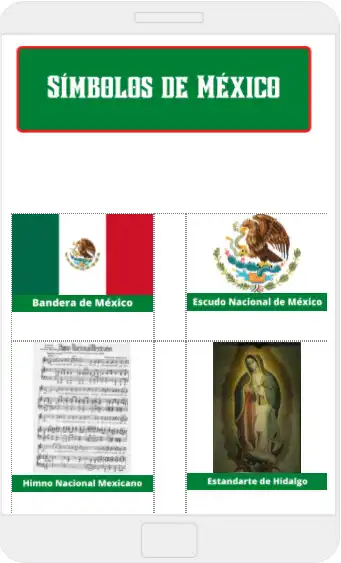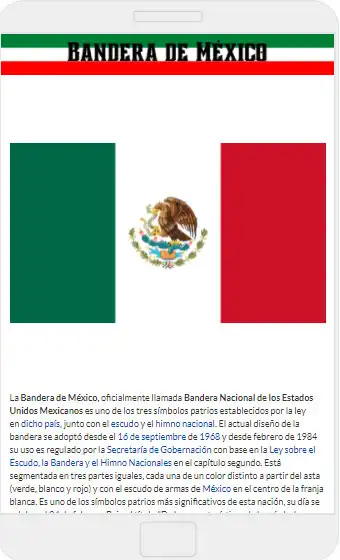Símbolos de México
Símbolos de México
The official app & game
Distributed by UptoPlay
SCREENSHOTS
DESCRIPTION
Use UptoPlay to play online the game Símbolos de México.
The constitutionalist eagle or Carrancista eagle is the symbol created by Venustiano Carranza as the shield of the Constitutionalist Army, the Executive Power of the Union and the process of the Political Constitution of the United Mexican States. Used in documentation, emblems, coins and bills, it was ratified by Abelardo Rodrguez as an element of the National Shield of Mexico, in force today.
The twin flags of Allende are a pair of flags that were made expressly by the then captain of the New Spain army Ignacio Allende for the armed struggle that would begin on October 1, 1810, but as the date of the armed uprising was advanced by the discovery of the conspiracy, the flags had to be used without further preparation, these flags were taken as a war trophy by the royalists and taken to Spain where they were kept in the Army Museum until they were exchanged for the Spanish flags captured from the Spanish General Isidro Barradas during the call Reconquest attempt of 1829, that exchange or swap occurred in Santillana del Mar, Spain on May 16, 2010, currently they are exhibited in the National Museum of History in the Federal District of Mexico
Dahlia (common name dahlia) is a genus of plants in the Asteraceae family. It is the national flower of Mexico.
The National Shield of Mexico, officially called the National Shield of the United Mexican States, is one of the three national symbols established by law in that country along with the flag and the national anthem. Its current design was adopted in September 1968.
It is inspired by the legend of the founding of Mexico-Tenochtitlan, according to which Huitzilopochtli told the Mexica to establish their city where they would find an eagle perched on a cactus; the city was located in the valley of Mexico, where today Mexico City is located.
A piece from the National Museum of History of Mexico (MNH) is popularly called the Banner of Hidalgo, which is made up of a piece of canvas painted in oil with the image of Our Lady of Guadalupe, on whose sides there are two shields, signs and in the lower part flowers painted with the same technique, and is characterized by two additional triangles in its lower part. This is just one coat of arms of the many that were captured from the insurgent forces at the beginning of the War of Independence.
The Law on the National Shield, Flag and Anthem is a set of norms and guidelines approved by the Mexican government concerning the display and use of the national flag, shield and anthem of Mexico. The original law was approved on February 8, 1984 in the Congress of the Union by then-president Miguel de la Madrid Hurtado.
The charro hat is a popular hat of Mexican culture, worn mainly by horsemen known as charros. It is of Spanish origin, from the Andalusia region and also from Navarra, where it was an accessory for wealthy landowners. It is made with wool felt, hare hair or wheat straw, and is a real protection against the bright sun. from Jalisco, and for the fall from the back of a horse. For this reason, the true charro hat has a wide brim, raised from the back; It has four "stones" in the cup that give it resistance in case of impact. For the latter case, the hat made of palm is better, which is more solid without being too heavy.
Enjoy with UptoPlay the online game Símbolos de México.
ADDITIONAL INFORMATION
Developer: worldofapplications24hours
Page navigation:


